BY CAROLE BRADEN | Sandra Kingsbury walked into the Fixers Night with a jumble of blown glass, milk glass and metal pieces. She left with a beautiful, working table lamp.
“We were ready to throw it away,” said Kingsbury, a resident at Westbeth Artists Housing, at 55 Bethune St. She had no idea what the tiered vintage piece should look like, but that didn’t slow down retired science teacher and repair guru Joe Holdner. He intuitively stacked components around a new center wire and turned the switch, sparking a literal lightbulb moment.
Posters pinned to bulletin boards around the Westbeth campus said, “Something broken? Don’t trash it. Repair it.” They invited residents to a pop-up tinkering session with the Fixers Collective, which Holdner helped found and has been part of for 14 years. The group, which has met monthly at Hack Manhattan on 37th Street for nearly a decade, is setting up a new neighborhood residency here at the West Village’s “home of the arts.” The next repair salon at Westbeth will occur on Wed., May 1, from 6 p.m. to 9 p.m.
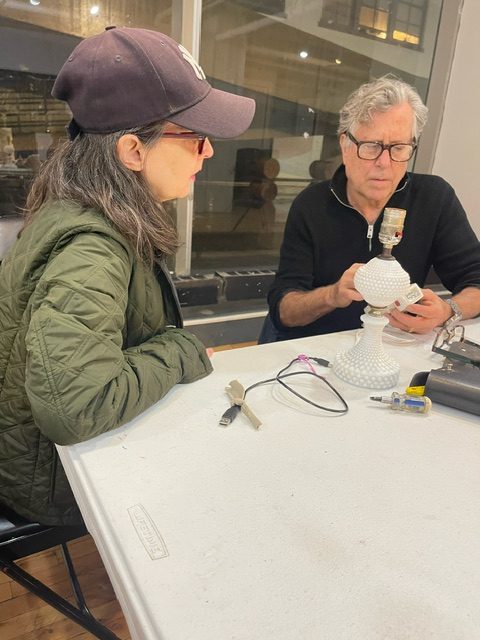
On that night in early March, Holdner was joined by Fixers Collective artists Vincent Lai and John Murphy, who unpacked implements and took places at power strip-equipped folding tables. Scheduled guests arrived with disabled objects and onlookers peeked into the brightly lit room wondering what was happening.
“It smells like fire,” said Charlotte Leist, a seventh-grader who wielded a soldering iron under Murphy’s supervision. She was installing new capacitators in her own mini makeup fridge, which had stopped chilling without warning. Empowered by making her “Swiftie” sticker-emblazoned plastic appliance cool again, she also gained a lesson: We can outsmart planned obsolescence.
The refurbishing event took place in a former daycare space facing Westbeth’s courtyard. Across the rain-swept corridor, the complex’s art gallery bustled with the in-progress opening of a show called “Women on the Verge.”
“I’d like to invite people over here for a little performance art,” Lai said, smiling, surveying the room as a screw gun squealed.
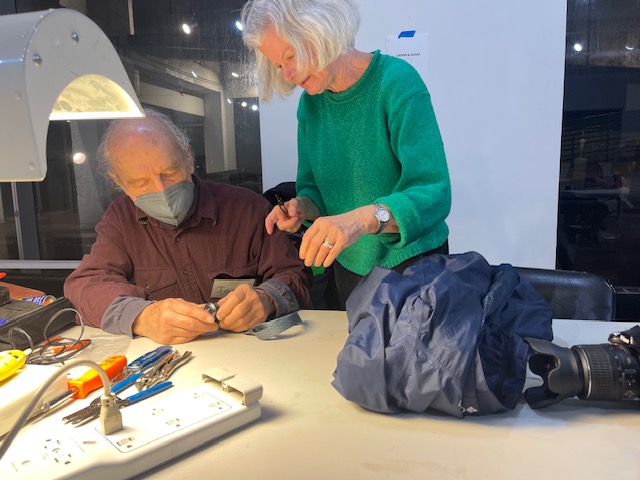
Lai, the group’s organizer and social media manager, is game to replace a smartphone battery or reupholster a chair. Lately, he’s been creating quick-release plates and other tripod parts on his 3D printer and searching for photographers who need them. The collective’s members seem to have the tools, parts and knowhow — or in a pinch, a YouTube video — to revive anything that stops working.
Skilled Westbeth residents showed up to work, too. Jenny Lombard, a retired teacher and author who grew up at Westbeth, came to repair jewelry. Richard Sanca, an animator, documentarian and former Bloomingdale’s art director-turned-cabinetmaker, was another familiar face. He moved to Westbeth 30 years ago and often works in the building designing and constructing storage units. On this night, among other tasks, he fixed two wobbly chairs and rehung a door on an old medicine cabinet.
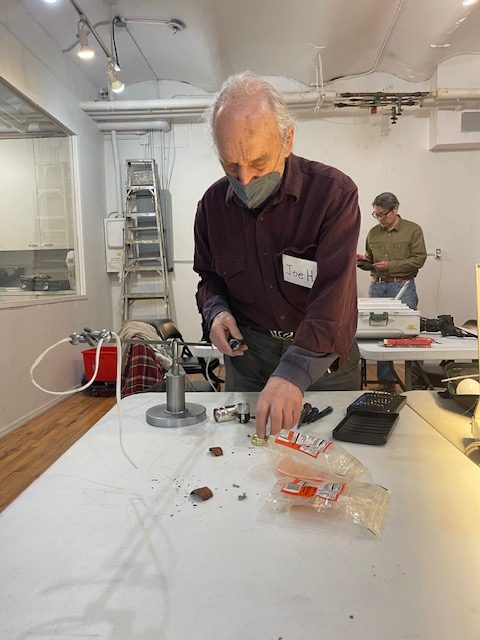
“It’s nicer to give something new life than to throw it out,” Sanca said. He noted that, despite the area’s high rents, not everyone can afford — or wants — to replace broken items with new ones. Westbeth Artists Housing opened in 1970 and continues to offer rent-stabilized apartments to resourceful artists of all disciplines.
Sanca mentioned the documentary short film “The Last Repair Shop”‘s Oscar win just a few weeks ago. Mom-and-pop shops are disappearing. But fixing nights offer hope for lame appliances and housewares, mechanical and electronic items, toys and more, as customers sit with fixers and participate in the repair process.
The Fixers Collective started in 2010 in Brooklyn at Proteus Gowanus, an interdisciplinary art gallery and reading space located in an old box factory. At an exhibition called “Mend,” someone brought a tattered American flag. People got to work repairing it. A movement — or a New York City arm of one — was born.
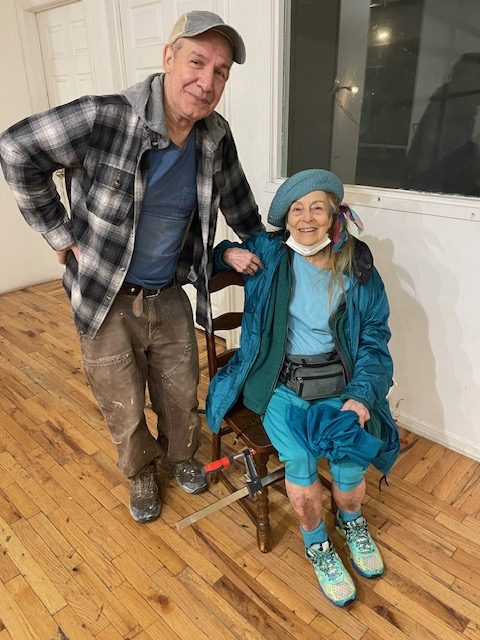
Like all New Yorkers, the Fixers Collective members did it their way, but they rode a wave. People’s motivation and ability to repair things had been languishing since at least the 1980s, as manufacturers and importers delivered more and more products essentially engineered to fail. Parts were plastic and manuals were elusive. Specialists and their shops disappeared. A concept called the Repair Cafe, conceived in the Netherlands in 2009, became a worldwide phenomenon and brought the ecological importance of fixing, versus tossing, to the forefront.
But as U.S. states and foreign governments began drafting fixer legislation — to give consumers the ability to repair their own electric devices and other equipment — the COVID-19 pandemic slowed the movement. Fixing events, often staffed by older adults, were shuttered and have only slowly reemerged in the last couple of years.
This past December, New York enacted its own long-fought-for Right to Repair law. Panned as “watered down” by critics, the measure addresses electronic devices, like smart phones and tablets, but could have sharper teeth. Under this new law, retailers like Apple and Samsung must offer parts and release technical manuals, enabling consumers to extend their products’ lives. The law also forbids warranty cancelations and other sales-driven, device-developer tactics.
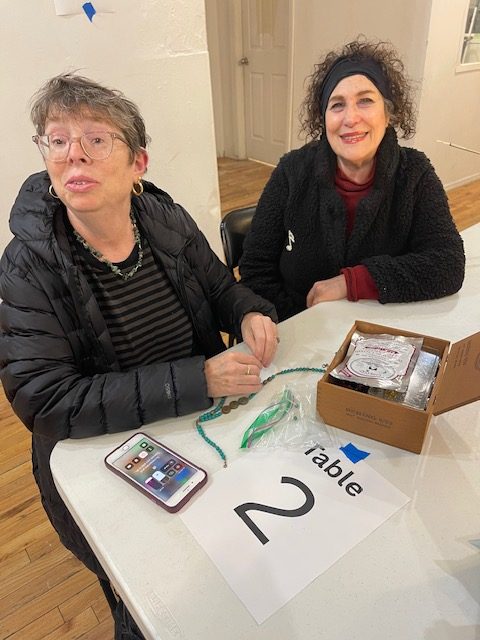
The Fixers Night pilot and other neighborhood repair events have the power to reignite a long-burning zeitgeist, growing awareness about climate change and consumerism’s role in it while providing welcome services. The Westbeth Artists Residents Council (WARC) and its Conservation Committee (which, full disclosure, this reporter leads) sponsored the three-hour event. Visitors brought a rollator — a walker on wheels — with bad brakes, a non-spinning CD player and five lamps, in addition to Kingsbury’s, plus more. Volunteers weighed and tallied 156 pounds of junk that went back to work instead of to the landfill.
Debra Rapoport, a found-metal jewelry and repurposed-textile artist, came with a nonworking 1960s Luxo gooseneck lamp. Holdner fixed the chrome light’s derelict switch by simply tightening a screw. Rapoport, a proud trash picker, was overjoyed.
“The concept of conservation and repairing and reusing,” she said, “is what I’m all about.”

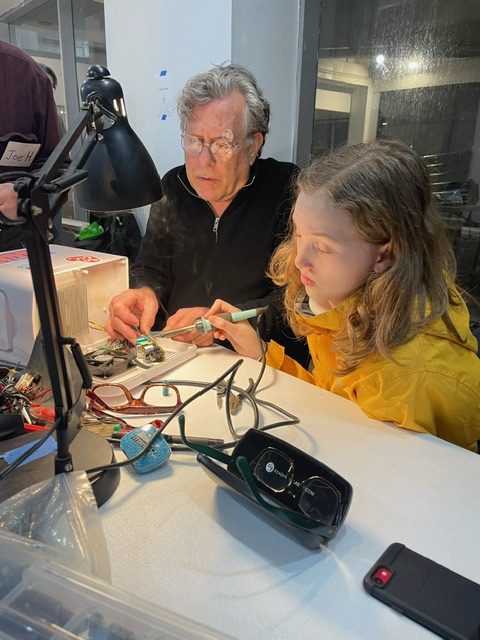
What a fantastic community of Fixers. I’ve never heard of the group, but it no doubt is mostly known on the East Coast.
Kudos to all involved. Keep up the good work. I Love my old stuff.
I am so grateful to Jenny for fixing my beloved Tibetan necklace!
That was so much fun getting my vintage lamp repaired. What a cool group of repair folks. Thanks!!!
When is the next one? Do you have to live in Westbeth?
The next Fixers Night at Westbeth is on Wednesday, 1 May from 6-9pm. The event is open to all neighborhood residents. Fixing is by donation, with a recommended contribution of $5 per item. Please email WestbethConservation@gmail.com in advance to secure a reservation. Hope to see you there!